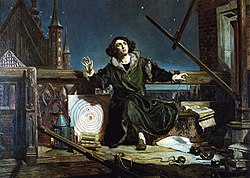Archcathedral Basilica of the Assumption of the Blessed Virgin Mary and St. Andrew, Frombork
| Archcathedral Basilica of the Assumption of the Blessed Virgin Mary and Saint Andrew in Frombork | ||
|---|---|---|
Year consecrated 1288, 1388 | | |
| Location | ||
| Location | Frombork, Poland | |
| Geographic coordinates | 54°21′25″N 19°40′54″E / 54.357083°N 19.681667°E | |
| Architecture | ||
| Style | Brick Gothic | |
| Completed | 1388 | |
| Specifications | ||
| Length | 90m | |
| Height (max) | 16m | |
| Materials | Brick | |
Historic Monument of Poland | ||
| Designated | 1994-09-08 | |
| Reference no. | M.P. z 1994 r. Nr 50, poz. 414[1] | |
Frombork Cathedral or the Archcathedral Basilica of the Assumption of the Blessed Virgin Mary and Saint Andrew (
The basilica is on Poland's official national
History
This section needs additional citations for verification. (December 2021) |

The original cathedral, completed in 1288, was a timber structure. It was called Ecclesia Warmiensis, indicating that it was the main diocesan building. In 1329, erection began of a brick and stone church and lasted until 1388, giving rise to the present cathedral. It comprises three naves 90 meters long and 16.5 meters tall, ending in a single chancel.
The building had no tower until the end of the 16th century, when a series of renaissance spires was added at the corners. In 1638, a clock was inserted in the central spire.
At the beginning of the 18th century, the church was enlarged on the northern aspect and a highly ornate portal was added to the entrance.
Between 1887 and 1891 the interior was radically refurbished, to achieve the extant decorative order. The artist Justus Bornowski of
Link to Copernicus

The astronomer and mathematician
In the northwest corner of the cathedral grounds is Copernicus' tower, and in the southwest corner an octagonal building with a square bell tower and a small planetarium and a Foucault's pendulum.
The city suffered destruction during the
The town and cathedral were badly damaged in World War II. After the war the cathedral was meticulously reconstructed.
See also
- Castles in Poland
References
- ^ a b Zarządzenie Prezydenta Rzeczypospolitej Polskiej z dnia 8 września 1994 r. w sprawie uznania za pomnik historii., M.P. z 1994 r. Nr 50, poz. 414
- National Heritage Board of Poland
- ^ J R Ravetz Plate, Nicolaus Copernicus 1473-1543 in Proceedings of the Royal Society of London, London 1602, p. 7 link
- ^ Copernicus skeleton identified The Guardian (November 22, 2008)
External links
- History and photos of the Frombork cathedral (in Polish)
